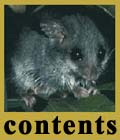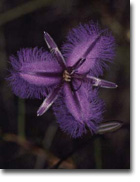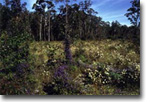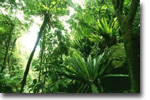 • welcome |
flora
Plant communities represent a range of types that are rare on the NSW south coast and poorly preserved in national parks and nature reserves. As many as 22 different vegetation associations have been identified in the Boodereee National Park alone. |
 |
| Dunes The area between beach and woodland is an inhospitable area for plants. Frontal dunes arc usually very unstable and have poor water-holding capacity. On the seaward slope, the first plants to stablise the sand are the grasses, Spiifex sericius and Festuca littoralis. On more stable areas Lomandra and Acacia occur. 0n the inner dune slope away from salt winds, leptospermum, clumps of Hibbertia climbers may occur. Shallow depressions which retain moisture often form between the dunes and some areas develop small lagoons immediately behind the dune area. |
| Mangrove and Saltmarsh Estuarine vegetation occurs in protected coastal areas along the tidal zone or on alluvial flats subject to regular tidal inundation but not exposcd to wave action. This complex consists of a sequence of zones determincd by the frequcncy and duration of flooding and salinity levels. On thc seaward edge of the mudflats is a zone of mangroves. Two species may be present, the taller Grey mangrove and thc shorter River Mangrove. River Mangrove is usually on thc landward side of Grey Mangrovc and often extends furthcr up estuaries where the water is less salty. Behind the mangroves may be a zone of saltmarsh, dominated by low succulent-stemmed Samphire and Seablite. Behind the saltmarsh, in areas infrequently covered by salt water,there is usually a rushland or reedland zone. Rushes dominate the boggy saline areas and the reeds grow in less saline swampy ground. Also found are small herbs and Casuarinas and Swamp mahogany on the slightly higher elevations on the landward side. |
| Woodland Woodlands are relatively open areas, dominated by trees (chiefly eucalypts), where the canopy foliage covers l0 to 30% of ground area. The scattered nature of woodland trees is often a result of drier conditions; hence woodlands are common on the less exposed positions than heaths. Eucalyptus gummifera, Banksia serrata, are common trees in the Jervis Bay woodlands |
| Open Forest Open forest consists of trees to 30 m tall, with a canopy cover of 30 to 70% of the ground area, and a dry understorey of smaller trees, shrubs, herbs and monocots. The structure is varied and species composition depends on the particular environmental condition. In the coastal zone, open forest occurs on plateaux with deeper sands, in gullies and on sheltered hillsides, especially on southern and eastern aspects. The main trees are Eucalyptus, Angophora, Banksia and Allocasuarina. Many of the most characteristic and beautiful of the regions wildflowers occur in the understorey of open forest, with species such as Telopea speciosissima(Waratah), Xanthorrhoea (Grass trees), Wattles and boronias being common. |
| Tall Open Forest This community is found on the richer fertile soils of basalt caps and eroded necks, on enriched soils of sheltered slopes and in deep sheltered gullies. It consists of trees 30 m or more tall, usually with straight trunks, with a canopy cover of 30 to 70%. Rainforest elements are often present in the understorey. In sheltered gullies of the coastal zone, Eucalyptus may dominate, while the understorey of these taller, wetter eucalypt forests usually includes many climbers and scramblers, and tall broad-leaved shrubs and a groundcover of ferns and monocots. |
Click on images for a bigger picture
Images ©


